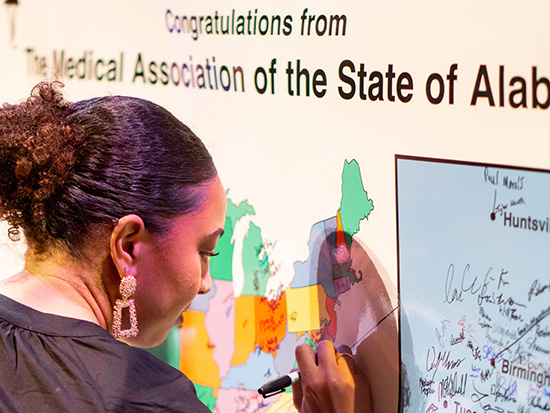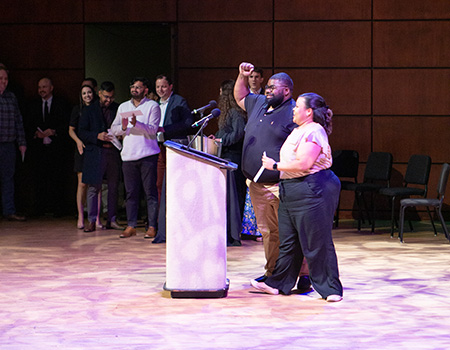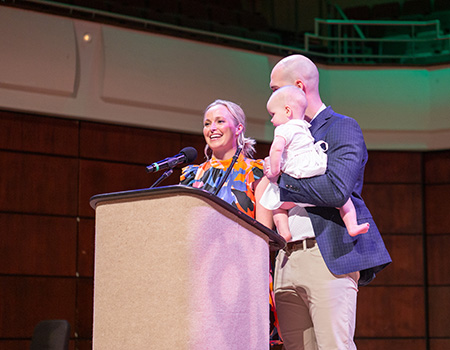Media contact: Alicia Rohan
 The 2022 graduating class of the University of Alabama at Birmingham Marnix E. Heersink School of Medicine celebrated a successful Match Day on Friday, March 18. With 100 percent of students matching into residency positions, UAB students will continue their medical training at 82 institutions in 30 states across the country.
The 2022 graduating class of the University of Alabama at Birmingham Marnix E. Heersink School of Medicine celebrated a successful Match Day on Friday, March 18. With 100 percent of students matching into residency positions, UAB students will continue their medical training at 82 institutions in 30 states across the country.
Mia Broughton was thrilled to match at her No. 1 choice: UAB’s dermatology residency program. She says she wants to impact communities of color and sees a need for more physicians who are dedicating time and resources to support those communities.
“Match Day represents a lot of hard work,” Broughton said. “I remember being a pre-med student, applying to get into medical school and getting so many rejection letters. To finally be able to get into medical school and now to match into such an awesome field of medicine, it is very surreal.
“I did not think I would make it this far, but I am so thankful to have my husband, Travis, and my family to support and encourage me,” Broughton added. “Medical school has meant a lot of dreams deferred for my family, and I’m just thankful to be able to fulfill those dreams now.”
Corey Duke, Ph.D., also matched into his top program: child neurology at Boston Children’s Hospital. Duke entered medical school at UAB in 2014 and transferred into the Medical Scientist Training Program, in which students take a sabbatical from medical school after their second year to complete their Ph.D. and then rejoin medical school to finish their clinical training.
 Mia Broughton
Mia Broughton
Photography: Tyler Furgerson“UAB truly believed in me and my potential before I did,” Duke said. “I couldn’t be happier with my training and with every opportunity I’ve had to develop as a leader and as a scientist.”
The match only continues to grow. According to the National Resident Match Program, which coordinates the residency match process, this year’s class was the largest on record, with more than 47,000 applicants from United States medical schools, international medical schools and osteopathic schools competing for 39,205 residency positions.
The largest number of UAB medical students matched into family medicine and internal medicine residencies, tied at 23 students each, followed by 18 in pediatrics, 18 in neurology, 11 in obstetrics and gynecology, and 11 in orthopaedic surgery. Students also matched in other medical specialties, including 10 in anesthesiology, eight in general surgery, seven in emergency medicine, seven in otolaryngology, five each in ophthalmology and psychiatry, four each in combined medicine-pediatrics and diagnostic radiology, three each in dermatology and radiation oncology, two each in child neurology, physical medicine and rehabilitation, thoracic surgery, vascular surgery and urology, and one each in interventional radiology and pathology.
 Kennon and Dan Brake
Kennon and Dan Brake
Photography: Tyler FurgersonKennon and Dan Brake entered the couples match and are staying in Birmingham for their training. Kennon matched into pediatrics at UAB, and Dan will train in family medicine at Cahaba Medical Care.
Kennon Brake says she could not be more excited to begin her pediatrics training at UAB and Children’s of Alabama.
“If you know anything about UAB, I think it’s understandable why people don’t want to leave,” she said. “I’m really excited for the opportunity to take care of kids, not only in Alabama but in surrounding states, and am excited to get to train in a place where I know I will see a wide variety of patient presentations.”
“I’m passionate about the underserved in medicine, and Cahaba provides an especially awesome opportunity for that kind of medicine that goes beyond diagnoses and treatments and really gets to taking care of the whole patient, whether that’s social issues, socioeconomic issues or family issues that contribute to their overall health,” Dan Brake said.